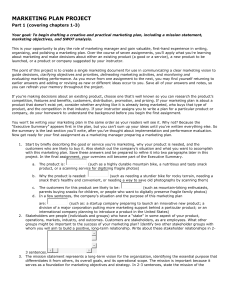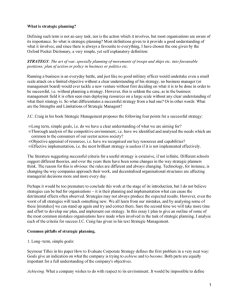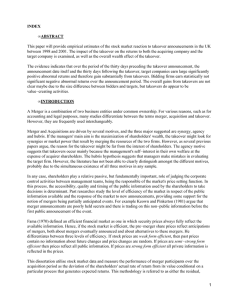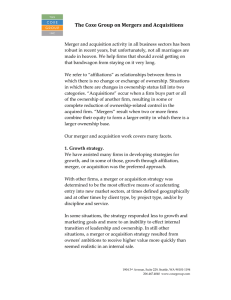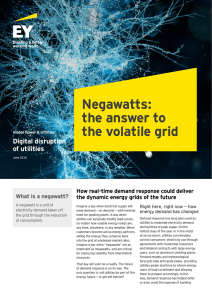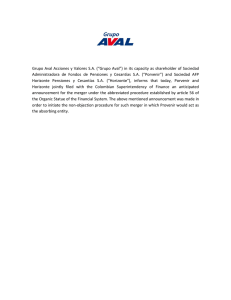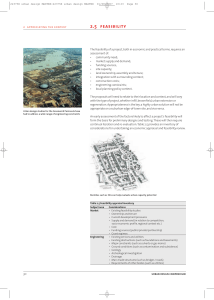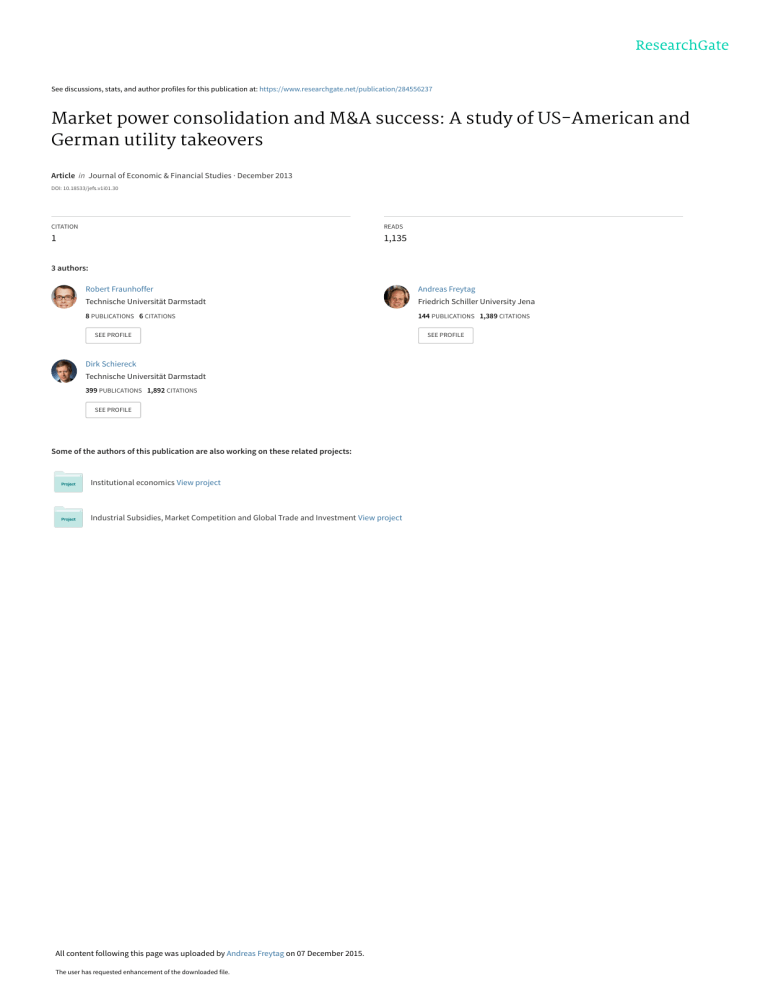
See discussions, stats, and author profiles for this publication at: https://www.researchgate.net/publication/284556237 Market power consolidation and M&A success: A study of US-American and German utility takeovers Article in Journal of Economic & Financial Studies · December 2013 DOI: 10.18533/jefs.v1i01.30 CITATION READS 1 1,135 3 authors: Robert Fraunhoffer Andreas Freytag Technische Universität Darmstadt Friedrich Schiller University Jena 8 PUBLICATIONS 6 CITATIONS 144 PUBLICATIONS 1,389 CITATIONS SEE PROFILE Dirk Schiereck Technische Universität Darmstadt 399 PUBLICATIONS 1,892 CITATIONS SEE PROFILE Some of the authors of this publication are also working on these related projects: Institutional economics View project Industrial Subsidies, Market Competition and Global Trade and Investment View project All content following this page was uploaded by Andreas Freytag on 07 December 2015. The user has requested enhancement of the downloaded file. SEE PROFILE Market power consolidation … Fraunhoffer, et al., JEFS (2013), 01(01), 29–43 Journal of Economic & Financial Studies, 01(01), 29-43 Vol. 01, No. 01: December (2013) Journal of Economic & Financial Studies Open access available at http://journalofeconomics.org Market power consolidation and M&A success: A study of US-American and German utility takeovers Robert Fraunhoffera, Andreas Freytagb, Dirk Schiereckc* Chair of Corporate Finance, Darmstadt University of Technology, Hochschulstrasse 1, 64289 Darmstadt, Germany, email: [email protected] b Chair for Economic Policy, Friedrich-Schiller Universität Jena, Jena, Germany, email: [email protected]. c Chair of Corporate Finance, Darmstadt University of Technology, Darmstadt, Germany Phone: 0049 6151 16 2323. * corresponding author email address: [email protected] a HIGHLIGHTS: 1. 2. 3. 4. Mergers and acquisitions (M&A) during the latest takeover wave between US-American utility firms did not lead to increased market power. Nevertheless, market value of merging entities appreciated on the day of the transaction. In contrast, in Germany the overall market power in the utility sector increased as a result of national mergers, particularly during horizontal transactions. Thus, the diverging regulation mechanisms and market structure of Germany and the US apparently influences the effect of national M&A in the utility sector. Article History ABSTRACT Received: 13-11-2013 Accepted: 20-12-2013 Available online: 26-12-2013 A wave of mergers and acquisitions (M&A) was observed in the North American and European energy utilities market. We analyze the impact of these M&A transactions on market power, studying 139 takeovers of energy utilities by applying event study methodology. Stock price reactions of acquiring and target firms as well as of their competitors are used to detect changes of market power. While we do not find any significant results pointing in this direction for transactions in the US, our findings indicate that the potential to increase market power is indeed an important motive for takeovers within the German energy utilities market. Keywords: Energy utilities; Mergers and acquisitions; Market power. JEL Classification: G14; G34; L16; L94; L95. DOI: http://dx.doi.org/10.18533/jefs.v1i01.30 © 2013 The Authors. This is an open access article under the terms of the Creative Commons Attribution License 4.0, which allows use, distribution and reproduction in any medium, provided the original work is properly cited. 1.0 Introduction In the 1990s, the market for corporate control experienced a boom of unprecedented proportions. In 1999 alone, the worldwide takeover volume was estimated to be 2.3 billion US$. By comparison in 1985, it was only 165 million US$, in 1992 286 million US$ (Pryor, 2001). Energy utilities were among the active players in this latest “wave of takeovers”. Pryor (2001) estimates that utilities accounted for 6.3% of worldwide takeovers in 1999 being the fifth most active industry. As of 2010, the energy sector has substantially increased in relevance while becoming the second most active industry sector (Schmid, Sanchez and Goldberg, 2012). The popularity of takeover strategies among energy utilities has been traced back to the extensive deregulation of many national energy supply markets: previously energy supply was seen as a natural monopoly requiring comprehensive regulation. From the beginning of the 1980s onwards, opinions shifted in America and later in Journal of Economic and Financial Studies. Page 29 Market power consolidation … Fraunhoffer, et al., JEFS (2013), 01(01), 29–43 Europe. Today, only certain sectors of energy supply are still viewed as natural monopolies (Isser, 2004; Kiesling, 2004). Legislators in many countries began to introduce elements of market competition. The Directive 96/92/EC and Directive 98/30/EC from 1996 and 1998 set common rules for the internal electricity and gas markets and they provided the foundation for the liberalization of energy supply in the individual European Union member states. In the United States, the structure of power markets changed significantly in the 1990s. Before, it was one of the most tightly regulated industries in the US. With the passing of the Energy Policy Act in 1992, the electricity wholesale markets were widely deregulated (Energy Information Administration, 2003a, 2003b; Verde, 2008). Despite the high empirical evidence of takeover strategies applied for energy utilities and suppliers which will be elaborated in the following section, remarkably little well-founded analysis is actually available about the motives. Most of the existing studies either maintain a general perspective without focusing on specific industries or explicitly exclude the utilities sector. The particular nature of energy supply, i.e. the aforementioned regulation and the resulting market structure, suggests that the drivers of the consolidation process might be very industry specific in this sector. Takeovers among energy utilities are usually justified by the management as a means of effecting increased efficiency, for example through operative synergies resulting from economies of scale and scope (Fraunhoffer and Schiereck, 2012a). Management synergies are a further possible motivation, where the superior management skills of the buying firm can be applied to the takeover target (Jensen, 1993; Gaughan, 2002). A number of studies of energy utilities in the US contain indications that the efficiency of energy utilities could indeed be increased as a result of takeovers (Bacon, 1997; Burns et al. 1998; Kwoka, 2006; Fabrizio et al., 2007). Another explanation suggests that mergers between energy utilities are driven by the intention of increasing market power and making collusive behavior easier (Kim and Singal, 1993; Mulherine and Boone, 1996; Tomback, 2002). However, the overall evidence for collusion effects following M&A announcements is rather mixed. For mergers in the airline industry Kim and Singal (1993) and Singal (1996) present consistent market reactions which hint towards collusive behavior. Stillman (1983), Eckbo (1983), and Eckbo and Wier (1985) also report findings in favor of expected collusive behavior, while the more recent results of Fee and Thomas (2004) and Sharur (2005) are inconsistent with this view. Despite these mixed results, the collusion argument seems a plausible motive for energy utilities as most national energy markets are dominated by a few main suppliers. In Germany, for instance, the three largest electricity producers supply approx. 60% of the entire market during the third merger wave. In other European markets like France, Ireland and Greece largest suppliers account for over 85% during the most recent merger wave (European Commission, 2004). At present, no specific empirical evidence is available that directly shows the attainment of market power through mergers and acquisitions among energy utilities. Two streams of literature provide evidence on the motives for mergers of energy utilities. Both concentrate on the analysis of the transaction outcome. Assuming shareholder-oriented behavior of the management, the outcome of the M&A transactions gives an indication whether increasing the firm value, e.g. through economies of scale and scope or through market power, is the major motive for applying an acquisition strategy. The first stream uses event study methodology to examine stock price reactions at the time of the merger announcement as measure for the outcome. In efficient capital markets the change of the stock price reflects all expected changes of future cash flows. Usually, the stock price reactions are analyzed separately for targets and bidders. Additionally, a few studies analyze the value for the combined entity of target and bidders. Overall, the cross-industrial evidence provides strong support that shareholders of target companies gain at the announcement of a merger (Bruner, 2004). With respect to the energy market, the results are mixed, in particular for the acquiring firm. McLaughlin and Mehran (1995) and Leggio and Lien (2000) report only insignificant stock price reactions. Other studies document positive announcement effects, though only for certain types of transactions. Bartunek et al. (1993), Berry (2000) along with Fraunhoffer and Schiereck (2012b) find negative announcement returns instead. For the combined entity of targets and bidders two studies measure positive announcement effects. These results for utility-specific takeovers are in line with the findings of event studies of acquisitions in general without any industry focus (Andrade et al., 2001; Moeller et al., 2005; Corrado, 2011). The second stream of literature examines the change in firm performance after an M&A transaction. Again, the results are mixed for the energy market. While Bacon et al. (1997) and Burns et al. (1998) observe an increase in performance after a merger, Khurana and Pereira (2002), Becker-Blease et al. (2008), as well as Ramos-Real et al. (2010) find decreases in the post-merger operating performance. Overall, both streams of M&A studies do not give a clear indication whether takeovers of energy utilities were primarily motivated by maximizing firm value or by other factors. The role of market power as a motive for mergers has not been focused in any of the studies discussed above. Journal of Economic and Financial Studies. Page 30 Market power consolidation … Fraunhoffer, et al., JEFS (2013), 01(01), 29–43 This paper analyzes the takeover and merger behavior of energy utilities during the most recent merger wave between 1990 and 2002 in the largest American market, the USA, and the largest European market, Germany. While the German market is already consolidated on an advanced level the US market structure is still rather dispersed. The more concentrated a market is, the more important is any further consolidating step and the more critical is the issue of market power. As an indicator of increased market power, stock prices of the acquiring and target firms as well as those of their industry competitors at the time of takeover announcement are measured and evaluated. While we do not find any significant results pointing in this direction for transactions in the US, our findings indicate that the potential to increase market power is indeed an important driver for capital market reactions following takeovers within the German energy utilities market. Remaining sections of this paper are structured as follows. The following section examines available cross-industry literature and develops hypotheses about the relationship between stock price reactions to takeovers and market power. Section 3 explains the data sample and methodology used. Section 4 details the results independently for takeovers and mergers in the US and German energy utility markets following the analyses of Thomas (2005). The final section summarizes the results and discusses conclusions. 2.0 Market power as a motive for utility takeovers While horizontal mergers are in the research focus when considering the relationship between takeovers and increased market power (e.g. Bhattacharyya and Nain, 2011; Hankir et al. 2011; Kutlu and Sickles, 2011), vertical and conglomerate acquisitions also influence the competitive behavior in electricity markets. The incentive for different businesses to adjust their production levels to match one another depends upon the inside-industry monitoring costs of collusive agreements. Horizontal mergers reduce the number of independent suppliers in the market place. When fewer suppliers are active in a market, the actions of the individual market actors are more visible and the probability that a non-conform increase in production levels (“cheating”) is detected becomes higher. The lower the monitoring costs are (i.e. the greater the likelihood that “cheating” is discovered), the better the stability, profitability and therefore the attractiveness of cartel agreements (Stigler, 1950; Eckbo, 1983; Bental et al., 2012). Agreements that are not explicitly arranged are called “tacit collusion”. Likewise, for this form of agreement the easier it is to predict the influence of a few market players on product prices and profits, the stronger the attraction to lower production levels. In more consolidated utility markets like Germany it is easier to follow a collusive behavior than in more dispersed markets like the USA. Whether explicit or implicit, such collusion promises monopoly-like returns for all suppliers as a result of higher market prices across the board (Weston et al., 1997). An important precondition for the effectiveness of this mechanism is a regulatory framework allowing the suppliers to implement price increases or to prevent price cuts. This has been the case in the United States for most of the electricity market since 1992 and for individual European countries since the mid-1990s. By contrast, the gas market in most European countries is subject to stronger price regulation. In the USA, however, a large proportion of the gas market has been open to competition since 1984. In a production-cost-oriented price regulated market, the attraction of building up market power is much reduced: even under pricing agreements with competitors, the utilities are not in a position to increase their prices autonomously without first obtaining permission from the regulation authorities, who base their recommendations on the cost of provision. If market power is expected to increase through a merger between two competitors, the announcement will have a positive effect on all other suppliers in the relevant market, as the probability of stable price agreements being reached rises. Contrary, increased efficiency as a motive and result for mergers is not expected to have a positive impact on competitors’ market position and firm value. The considerations above relate to horizontal mergers, as this kind of takeover reduces the number of competitors in the market and decreases the monitoring costs for collusive agreements. An alternative means of increasing market power is through vertical or conglomerate takeovers. Advocates of the “mutual forbearance” theory initially proposed by Edwards (1955) identify two mechanisms in which, through implicit collusion among competitors across several different markets, an increase in market power can be achieved (Jayachandran et al., 1999; Bilotkach, 2011). They argue that firms who compete with one another in more than one market (so-called “multi-market contact”) are more likely to consider each other as rivals and will therefore collect detailed information about the other. The more information they have, the better they are able to assess the interdependency of their own actions and the reactions of their rival. It is only through this “familiarity”, according to Baum and Korn (1999), with the behavior of the rival that a form of tacit collusion becomes possible, from which both parties benefit. In order for some kind of agreed behavior to actually become effective, the respective competitors must be aware of the potential of the other to cause massive financial damage in response to possible own aggressive market behavior. If this kind of deterrent (Edwards, 1955) is not effective a strong market actor will have no interest in Journal of Economic and Financial Studies. Page 31 Market power consolidation … Fraunhoffer, et al., JEFS (2013), 01(01), 29–43 taking a less aggressive stance towards weaker rivals (Teece et al., 1997). In general, “multi-market contact” implies that competitors have a variety of means of causing damage to their rivals. In such cases, the deterrent can be particularly effective (Steiner, 1975). A conglomerate acquisition can increase the deterrent potential if it enables a firm to enter their rival’s most important market. If the competitor is also present in the first firm’s primary market, it can be of benefit to both to tacitly agree to refrain from intensive competition with one another. The “mutual forbearance” hypothesis has, for the most part, been supported in previous empirical studies, although contradictory evidence is also available (for an overview see Jayachandran et al. 1999). In addition to “mutual forbearance”, firms with diverse interests in several markets are also able to strengthen their market power by cross-subsidization of individual branches with the profits of other more lucrative areas. This can help a firm to strengthen and improve its market position in the subsidized branch (Trautwein, 1990). To summarize, conglomerate takeovers can also promote collusive behavior and lead to the strengthening of market power. This is, however, only possible under the aforementioned conditions. This limitation means that one would expect the motive “market power” to play a role in a smaller proportion of conglomerate transactions when compared with horizontal mergers. According to this line of reasoning, the stock price reactions for competitors to conglomerate transactions can be expected to be lower on average. The following four hypotheses summarize the above discussion. We will follow two research questions with respect to the overall observation of announcement effects and two hypotheses to explain the effects. Hypothesis 01: Any kind of M&A transaction in the energy utilities industry can promote collusive behavior and thereby facilitates the exploiting of market power. Conglomerate mergers between electricity or gas utilities therefore lead also to an increase in the market value of industry competitors in the national market. Whereas this hypothesis holds for all kinds of mergers (horizontal, vertical, conglomerate), in hypothesis 2 we concentrate on horizontal mergers and their impact on competitors, again testing the existence of the “mutual forbearance” theory in the energy market. Hypothesis 02: Horizontal mergers within national markets are a particularly effective means to increase market power. Their announcements result in more pronounced stock price reactions for national competitors within the industry than other forms of M&A transactions do. Results of several studies do indeed contain indications that there is a positive relationship between the announcement of a merger and a change in the market value of competitors (Eckbo, 1983; Jensen 1983; Stillman, 1983; Eckbo and Wier, 1985; Mitchell and Mulherin, 1996; Song and Walkling, 2000; Cai et al., 2012). A proof of this relationship may be a necessary condition but not a sufficient one for the market power hypothesis. Eckbo (1983) argues that a positive relationship can also be attributed to an information effect. For instance, this would be the case when the capital market assumes that as a result of the merger, the firms will be able to pursue more efficient production and/or investment strategies. As close competitors often have similar production methods, a merger can signalize that competitors may also be able to make use of this efficiency potential through additional mergers in the future. Song and Walkling (2000) along with Cai et al. (2012) extend this argumentation by examining whether the stock price reaction is dependent upon the fact that further mergers are to be expected within the industry. Song and Walkling (2000) report that unexpected merger announcements, i.e. announcements which mark the end of a period of low takeover activity in a market, do trigger stronger stock price reactions by their non-merging competitors. Furthermore, the reactions are particularly marked by competitors who could themselves become a possible target of a future takeover. Their findings reinforce the acquisition probability hypothesis, which posits that it is not the increase in market power that is responsible for the positive stock market price reactions of competitors but rather the message that a takeover announcement communicates about the possibility of future takeovers. Hypothesis 03: The announcement of mergers between electricity or gas utilities is a signal for potential increased efficiency. This leads to an increase in the market value of non-merging competitors. This is more pronounced at the beginning of a wave of takeovers or mergers than towards the end of such a phase. However, in markets where the number of potential acquisition targets is large the effect of increased acquisition probability can be overcompensated by the challenge to reach higher efficiency levels. Journal of Economic and Financial Studies. Page 32 Market power consolidation … Fraunhoffer, et al., JEFS (2013), 01(01), 29–43 Hypothesis 04: The announcement effect on the market value of non-merging competitors is particularly strong in a positive direction when they themselves are deemed potential targets of future takeovers. Differences between the regulation and the structure of the US-American and German utility markets raise the expectation that the relationship between mergers and market power could differ for both reason. Where in Germany the wholesale sector of the electricity market has been deregulated since 1997, this is not the case for all federal states in the USA (Energy Information Administration, 2003b). Market power is only an advantage when it can be used to bring about a rise in sales prices. This is not always possible when operating within regulated markets. Furthermore, market power is easier to exploit in more concentrated markets. Whereas in the USA the largest three energy suppliers cover approximately 8% of the entire capacity (Energy Information Administration, 2005) during our research time frame, in Germany the top three cover 61% of the market (European Commission, 2004). Positive capital market reactions in the USA should therefore be more driven by efficiency gains while in Germany market power is an important factor. 3.0 Data and methodology For the following analyses, the United States of America has been selected as the largest national market in North America, and Germany as the largest national market in Europe. At a country level market power is especially relevant for larger companies. Agreements between smaller suppliers have a limited effect on general market prices as their lower production levels only apply to a small segment of the market. As a significant number of energy utilities in the USA are publicly listed on the stock exchange, in a first step only the largest suppliers in the year of the respective M&A announcement (as given in the Compustat database) are considered. The generated turnover serves as the selection criteria for the ten largest gas and the ten largest electricity suppliers of the particular year. In a subsequent step, the transactions of the ten largest electricity and gar acquiring firms were selected from the overall transaction sample. In Germany the proportion of publicly listed companies is traditionally lower. From the beginning of the 1990s, only 32 electricity and gas utilities are listed, eight of which only for a limited period. As these utilities all operate within the relatively confined area of Germany (in comparison to the extensive North American supply network) and most of them provide both electricity and gas, all the utilities in Germany have been considered potential competitors. The takeovers and mergers among European and North American energy utilities during the complete merger wave between 1990 and 2002 were identified for this study using the following information sources. We thereby also ensure that each event considered is mutually exclusive. a. Thomson SDC International Mergers and Acquisitions Database, b. Zephus M&A-Database, c. M&A-Review Transaction database, d. Finance Deal database, e. Bloomberg, f. VDEW Database – Co-operations and takeovers among German electricity utilities. The market values of acquiring and target firms were obtained from the Datastream database. The calculation of daily returns as well as market indices is based on a Total Return Index which are also derived from Datastream. For additional, accounting-related information on merging companies, such as balance and profit and loss information, the Compustat database (for US-American companies) and the Wordscope Disclosure databases were used for Germany firms as well as the annual reports of the respective companies derived from the respective investor relations department. The transactions selected for the study were chosen according to the following criteria: a. The acquiring firm is an electricity or gas supplier with headquarters in the USA or in Germany. b. The acquiring firm is publicly listed or has a majority stake in a publicly listed electricity or gas utility in Germany or the United States. c. The M&A transaction was not a part of a bidder consortium. d. Stock price information is available for the period of 20 days prior and 20 days after the e. transaction. In the period 20 days before or 20 days after the transaction announcement, the acquiring firm only announced the very transaction. Overlapping transactions are excluded to prevent any bias in the estimation period. f. The transaction was announced between 1 st January 1990 and 30th September 2002 (i.e. the third merger wave). g. The transaction was closed. Journal of Economic and Financial Studies. Page 33 Market power consolidation … h. Fraunhoffer, et al., JEFS (2013), 01(01), 29–43 The transaction value exceeded 1 million US$. To name some of the real life examples from our dataset there is the most important German deal with the merger of Veba and VIAG in 1999, the merger of Pacificorp and Scottish Power in 1998 and the merger of Niagara MohawkHolding with National Grid Group in 2000. During the given period a total of 70 transactions show the following properties: the acquiring firm is located in the USA; it was one of the 10 largest electricity or gas utilities at the time of transaction announcement; and sufficient share price information is available for calculating capital market reactions. For Germany, 69 cases fulfill the equivalent criteria. For each transaction we investigated for each target and acquiring firm the respective valuechain position which in a subsequent step enabled us to characterize the merger as being horizontal or vertical. For the above M&A transactions, the stock price reactions for the acquiring and target firms as well as their competitors were determined using a methodology that takes into account the comparatively rapid succession of events after such an announcement. Therefore, for this part of the analysis, a market model not requiring an estimation period was used and applied to only short event periods: AR jt R jt R mt (1) where ARjt is the abnormal rate of return for security j of a competitor; R jt is the rate of return for security j on day t, and Rmt is the rate of return for the market index m on day t. Resulting abnormal returns are cumulated (CAR) over different time periods for each firm and the entire sample to retrieved the average abnormal rate of return (AAR). We thereby introduce various event windows around the event day {0} to control for a possible information leakage. Brown und Warner (1980) were able to demonstrate in a comparison that the differences between this model and a risk-adjusted market model are relatively small, especially for short event periods. More recent studies commonly use this approach, especially where events often overlap (e.g. Fuller et al., 2002; Bouwman et al., 2012). For the USA as a large national market, a national utility index containing the largest publicly listed utilities of the respective country was used as a market index. For Germany, as a small national market, a general cross-industry index was used. Due to the small number of publicly listed utilities in Germany, the respective Datastream UtilityIndex is based on 12 firms only while we utilize 58 firms for the US market. Possible stock price reactions of competitors would therefore directly affect the index rate of return and distort the calculation of abnormal rates of return (Fuller et al., 2002). As a check for robustness we recalculated the analysis for the US firms using a general market index with the results remaining identical. To determine the net change in value for the shareholders of acquiring and target firms, the average abnormal rate of return for a hypothetical combined entity was determined while value weighting (with the respective market value five days prior to the M&A announcement) each entities abnormal return. This calculation allows us to draw conclusions about a possible prosperity transfer between the shareholder groups of the respective firms. 4.0 Empirical results 4.01 Takeovers of US-American utilities Table 1 lists the stock price reaction for the acquiring firms (column 2) and their competitors (column 3) at the time of announcement of takeovers in the US-American utilities market. We waived separate presentation of returns for gas and electricity suppliers because we did not find any significant differences between these two subsamples. For the acquiring firms the cumulative abnormal rate of return is negative for all event periods examined, although is not statistically significant for any of the event periods analyzed. This observation suggests that from the perspective of the capital market, the transactions on average did not have an impact on the value of the acquiring firm. Table 01: Abnormal rate of return for US energy utilities Stock market reaction for the Stock market reaction for the industry competitors acquiring firm CAR CAR Positive Negative z-value [-5;+5] -0.16% -0.34%** 273 316 -2.2302 [-2;+2] -0.83% -0.16% 278 311 -1.5096 [-1;+1] -0.53% -0.21%** 266 323 -2.3861 {0} -0.19% -0.18%*** 246 343 -3.7045 n 70 589 * significant on a 10%-level ** significant on a 5%-level ***significant on a 1%-level Journal of Economic and Financial Studies. Page 34 Market power consolidation … Fraunhoffer, et al., JEFS (2013), 01(01), 29–43 However, for the acquiring firm’s competitors in the market, the takeover announcement leads to a slight but significant decrease in their stock price value. For the interval [-1;+1] the cumulative abnormal rate of return for the industry competitors was -0.21% (significant at a 1%-level). The mean value difference between the cumulative abnormal rate of return of acquiring firms and that of the competitors is not significant. These results do not correspond with Hypothesis 1, which posits that the market values of the industry competitors rise in response to a takeover announcement as a result of overall increased market power. Table 2 compares the cumulative abnormal rate of return for the hypothetical combined entity with that of the acquiring firm’s industry competitors at the time of takeover announcement. For only 25 of the overall 70 transactions the takeover target was a publicly listed firm allowing us to calculate the cumulative abnormal returns for the hypothetical combined entity. The announcement effects for these combined entities are considerably higher than the effects of their competitors, and positive for all the event periods examined, though significant only on the day of the announcement and for the interval [-5+5]. This suggests that the combined entities of acquiring and target firms can strengthen their position through a merger at the cost of their competitors. However, it appears that only the shareholders of the takeover targets actually benefit from the improved market position. Table 02: Abnormal rates of return for the combined entity in the US Reaction for Reaction for Reaction for the the the industry acquiring combined competitors firm (1) entity (2) (3) Mean difference (2) – (3) CAR CAR CAR Difference t-value p-value [-5;+5] -1.03% 1.51% * -0.56% * 2.06% ** 2.2667 0.0243 [-2;+2] -1.74% 1.06% -0.56% ** 1.61% * 1.9438 0.0531 [-1;+1] -1.82% 1.11% -0.46% ** 1.57% ** 2.3210 0.0212 {0} -0.49% 1.28% ** -0.23% ** 1.51% *** 4.0670 0.0001 n 25 25 207 * significant on a 10%-level ** significant on a 5%-level ***significant on a 1%-level The unequal distribution of benefits from a merger is consistent with the “winner’s curse” hypothesis (Varaiya, 1988). This hypothesis claims that the potential acquiring firm overestimates the advantages of a takeover, and is more likely to win against competing bids as they are more willing to pay a higher price / a higher takeover premium. According to Hypothesis 2 positive stock price reactions are to be expected for industry competitors in the case of horizontal mergers between electricity or gas utilities. Table 3 compares the stock price reaction for energy utilities to the announcement of a horizontal merger with the competitors’ reaction to all other takeover announcements. Horizontal mergers were taken to be all transactions where the acquiring firm or target firm was either an electricity or gas supplier. Table 03: Abnormal rates of return for US energy utilities targets of horizontal mergers Horizontal merger of a national target firm All other takeovers Mean difference CAR CAR Difference t-value p-value [-5;+5] -0.60% -0.31% -0.29% 0.4434 0.6577 [-2;+2] -1.24% -0.03% -1.21% ** 2.5415 0.0113 [-1;+1] -0.64% -0.15% -0.49% 1.3123 0.1899 {0} -0.26% Mean transaction volume ($m) 2,842 -0.17% *** -0.08% 0.4149 0.6784 N 65 * significant on a 10%-level * 831 2,012 524 ** significant on a 5%-level *** 6.6013 0.0000 ***significant on a 1% level In contrast to expectations, the cumulative abnormal rate of return of the industry competition is negative throughout (significant at a 10%-level only for [-2;+2] interval) and lower for almost all intervals than for all other kinds of transaction announcements (significant at a 5%-level for the [-2;+2] interval). Hypothesis 2 therefore has to be rejected for takeovers among US-American energy utilities. It cannot be ruled out that this result has been Journal of Economic and Financial Studies. Page 35 Market power consolidation … Fraunhoffer, et al., JEFS (2013), 01(01), 29–43 distorted by a size effect. The average transaction volume of the first test sample is significantly lower than that of the remaining acquisitions. As a next step we analyzed whether the stock price reactions observed can be explained by Song and Walkling (2000) and their “acquisition probability” hypothesis (Hypotheses 3 and 4) rather than by a desire to increase market power. The authors reason that the significant positive abnormal change in value as a reaction to takeover announcements by a competitor, as observed in their studies, can be explained by the increased probability that the competitors themselves may become the subject of a future takeover. Unlike in Song and Walkling (2000), the findings here do not exhibit a positive abnormal change in market value for the competitors. Therefore, hypotheses 3 and 4 cannot be supported by the analysis of the takeovers of US-American utilities. In a nutshell, the results suggest that the utility takeovers observed in the US cannot be explained by the motive to increase market power. The positive announcement effects for the combined entity of acquirer and target company together with the negative effects on their competitors provide some evidence that the merging companies can strengthen their position through a merger at the cost of their competitors. The findings from the above dichotomous investigations have been controlled for by using a multivariate regression analysis. As the dependent variable, the cumulative abnormal rate of return for the respective competitor firm for the interval [-1;+1] was chosen. The following independent variables were used for the various different regression models: “CAR acquiring firm” is defined as the cumulative abnormal rate of return for the acquiring firm; “CAR hypothetical combined entity” is the cumulative abnormal rate of return for the hypothetical combined entity; “Horizontal merger” is a dummy variable where the value “1” denotes that the transaction involves the takeover of a US electricity supplier (or gas supplier) by another US electricity supplier (or gas supplier); “Competitor, later themselves target of takeover” is again a dummy variable where “1” denotes that the competitor under consideration at the time of the announcement later themselves became the target of a takeover. These variables are required in order to assess the “acquisition probability” hypothesis by Song and Walkling (2000). In order to test whether the stock price reaction for the competitors changes depending upon the time-frame and takeover activity intensity, the sample was additionally separated in two time frames: “Phase 1997-2002” is a dummy variable where the value “1” denotes that the respective transaction was announced in the second ‘phase’ of the sample duration. As final control variable, the “transaction volume” was also included. The transaction volume serves as an indicator for the importance of the takeover from the perspective of acquiring firm and its branch competitors. This is used in place of a relative indicator (for instance turnover relationship of acquiring and target firms) for two reasons: firstly, it exhibits strong negative correlation (-0.7) with the turnover relation of acquiring and target firm, and secondly, the use of turnover relationship as descriptive variable would have reduced the sample from 589 to 173 as a result of insufficient available data. In addition, a separate analysis showed that the turnover relationship (as likewise the transaction volume shows) has no significant influence on the intensity of the announcement effects for the branch competitors. The statistical relationship between the stock price reaction for competitors and the independent variables was analyzed using five models. The results of the multivariate analysis are shown in Table 4. In model 1 the abnormal cumulative rate of return for the acquiring firm and that of the hypothetical combined entity are taken as influencing variables. The regression coefficient for the stock market reaction for the acquiring firm is positive (significant at a 1%-level). The coefficient for CAR of the hypothetical combined entity is by contrast not significant. These results support the observations made in the dichotomous analysis: there is a statistical relationship between the abnormal market value development of the acquiring firm and that of its competitors. The larger the value decrease of the acquiring firm is, the larger the corresponding decrease in market value of its competitors. Table 04: Multivariate analysis of competitor reactions in the US Model 1 Model 2 Model 3 Model 4 Model 5 Constant -0,0012 0.0016 0.0006 -0.0002 -0.0002 (-0.953) (0.646) (0.225) (-0.152) (-0.159) CAR acquiring firm 0.2535 *** 0,1904 *** 0.2067 *** 0.1894 *** 0.2068 *** (5.913) (6.089) (4.550) (7.186) (6.357) CAR combined entity -0.0690 (-1.093) Horizontal merger 0.0008 0.0010 (0.209) (0.289) Competitors, later -0.0018 target of takeover -0.0019 (-0.666) (-0.688) Journal of Economic and Financial Studies. Page 36 Market power consolidation … Fraunhoffer, et al., JEFS (2013), 01(01), 29–43 Phase 1997-2002 -0.0034 (-1.246) Transaction volume 0.0000 (-0.179) 2 R 0.0591 0.0615 0.1051 0.0921 0.0922 Adj. R2 0.0559 0.0583 0.0963 0.0885 0.0852 F-Value 3.9130 6.0900 ** 8.6344 *** 6.3555 ** 5.1515 ** N 207 589 589 518 518 * significant on a 10%-level, ** significant on a 5%-level, ***significant on a 1%-level. t-value in parenthesis This result does not support hypothesis 1. None of the remaining independent variables had a significant influence on the level of abnormal cumulative returns for the competitors. The values for (adjusted) R2 are relatively low, but lie within a typical range for financial multivariate analyses. cf. for example Hubbard and Palia (1999), p 1143; Leeth and Borg (2000), p 233; Fuller et al. (2002), p 1787 and especially the comments by Haleblian and Finkelstein (1999), footnote 9, p 47. The results are not consistent with the hypothesis, that takeovers and mergers significantly strengthen the market power of the merger firms and that of their competitors. 4.02 Takeovers of German utilities Table 5 shows the cumulative abnormal rate of return for German energy utilities and their competitors at the time of a takeover announcement. Table 05: Abnormal rate of return for German energy utilities Stock market reaction for the acquiring firm Stock market reaction for the industry competitors CAR CAR Positive Negative z-value [-5;+5] -0.96% 0.54% *** 761 644 4.8909 [-2;+2] -1.26% *** 0.26% *** 750 655 3.4469 [-1;+1] -0.27% 0.43% *** 722 683 6.9580 0.21% *** 1,405 ** significant on a 5%-level 657 648 6.6752 {0} -0.14% N 69 * significant on a 10%-level ***significant on a 1%-level As observed for the US-American energy utilities, the market value of the acquiring firm in Germany decreases on average. The negative cumulative abnormal rate of return which can be observed for all event periods, is only significant for the event period [-2;+2]. However, for the competitors a different picture is shown: for all event periods analyzed the cumulative abnormal rate of return is positive (significant at a level of 1%). Table 6 below compares the cumulative abnormal rate of return of the hypothetical combined entity with that of the acquiring firm’s competitors. As the target firms were publicly listed in only 34 cases the sample size reduces. The abnormal changes in market value for the combined entity are positive, though not significantly above zero. The stock price reactions for the competitors are also positive (significant at a level of 5% for day {0} and the event period [+5;-5]). The difference between the CAR of the combined entity and that of the competitors is not significant. The hypothetical combined entity could not improve its market position with regard to its competitors. Table 06: Abnormal rate of return for the combined entity in Germany Reaction for Reaction for Reaction for the the acquiring the combined industry Mean difference (2) – (3) firm (1) entity (2) competitors (3) CARCAR CAR difference t-value p-value [-5;+5] -0.96% 0.68% 0.39%** 0.29% 0.2924 0.7700 [-2;+2] -1.26%*** -0.05% 0.11% -0.15% 0.1912 0.8484 [-1;+1] -0.27% 0.97% 0.19% 0.77% 1.3405 0.1805 {0} -0.14% 0.42% 0.13%** 0.30% 0.9426 0.3462 n 34 34 693 Journal of Economic and Financial Studies. Page 37 Market power consolidation … * significant on a 10%-level Fraunhoffer, et al., JEFS (2013), 01(01), 29–43 ** significant on a 5%-level ***significant on a 1%-level To summarize, the findings are consistent with Hypothesis 1, in which increased market power is seen as an important motive for takeovers and mergers. According to Hypothesis 2 market power is achieved more effectively through horizontal mergers within the same national market. In this case, higher abnormal rates of return are to be expected for the competitors. Table 7 compares the abnormal market value development for the competitors upon the announcement of a national horizontal merger compared with that when other kinds of takeovers are announced. Table 07: Abnormal rate of return for German energy utilities Horizontal merger of a national target firm All other takeovers Mean difference CAR CAR difference t-value p-value [-5;+5] 1.20%*** 0.17% 1.03%*** 3.0373 0.0024 [-2;+2] 0.27% 0.11% 0.16% 0.6132 0.5398 [-1;+1] 0.56%*** 0.26%*** 0.30% 1.4756 0.1403 0.14%*** 0.17% 1.4331 0.1520 {0} 0.32%** Mean transaction value ($m) 759 N 368 * Significant on a 10%-level 1,511 *** 1,037 ** significant on a 5%-level -752 ** 6.7191 0.000 ***significant on a 1%-level The results confirm that for all event periods, the abnormal rate of return for the competitors in the case of national horizontal mergers is higher than for the comparison group. The difference in CAR between the two is, however, only statistically significant for the [-5;+5] interval. The results of Table 7 could therefore be seen as a weak confirmation of Hypothesis 2. Hypotheses 3 and 4 are based upon the “acquisition probability” theory by Song and Walkling (2000). The theory explains the increase in market value of the industry competitors as a result of a takeover announcement by arguing that the investors see the probability rise that the competitors themselves may subsequently become the target of a takeover. According to Hypothesis 3, the announcement effects for the competitors in the first phase of a takeover wave will be higher than in the later phase. Table 8 compares the CAR for the industry competitors for the period 1990-1996 and 1997-2002. The results do not confirm Hypothesis 3. The differences between the mean announcement effects of both phases are inconsistent and insignificant. Table 08: Abnormal rate of return for German utility competitors for the first and second takeover waves Takeover Takeover announcements announcements between between 1997 and 1990 and 1996 2002 Mean difference CARCAR CAR difference t-value p-value [-5;+5] 0.36%* 0.59%*** -0.24% 0.6502 0.5157 [-2;+2] 0.27%* 0.26%** 0.01% 0.0323 0.9742 [-1;+1] 0.41%*** 0.43%*** -0.02% 0.0868 0.9309 {0} 0.10%* 0.24%*** -0.14% 1.0959 0.2733 Mean transaction volume ($m) 450 1,073 -623* 4.8026 0.0000 Number 318 1,087 * significant on a 10%-level ** significant on a 5%-level ***significant on a 1%-level Journal of Economic and Financial Studies. Page 38 Market power consolidation … Fraunhoffer, et al., JEFS (2013), 01(01), 29–43 Table 9 compares the mean CAR for the industry competitors for three time frames in the sample time period. The highest announcement effects were observed between 1994 and 1998 (second phase). The CAR for this phase is significantly higher than for both the earlier and later time frames. Unlike the results for the USA, a waveform pattern of development for the market reactions to takeover announcements can indeed be put forward. These findings support, at least in part, the “acquisition probability” hypothesis. The higher mean CAR for the competitor in the second phase could be interpreted as an advance anticipation of the large number of takeovers to follow in the years after. Table 09: Abnormal rate of return for energy utilities during takeover waves Phase 2 Phase 3 Phase 1 Mean difference Takeover Takeover Takeover Phase 1 Phase 1 Phase 2 announcemen announcement announcemen Phase2 - Phase Phase 3 ts 1990-1993 s 1994-1998 ts 1999-2002 3 [-5;+5] [-2;+2] [-1;+1] {0} 0.54%* 0.09% 0.24% 0.26%*** Mean transaction volume ($m) 666 N 148 0.27% 0.67%*** 0.87%*** 0.23%* 0.63%*** 0.16% 0.31%*** 0.20%*** 0.27% -0.57%* -0.63%* 0.04% -0.09% -0.07% -0.08% 0.06% -0.36% 0.51%* 0.56%** 0.03% 984 307 1.117 950 -318* -451** -133 * significant on a 10%-level ** significant on a 5%-level ***significant on a 1%-level The waveform progression also suggests that the intensity of regulation has no systematic influence on the “acquisition probability”. The intensity of the energy market regulation has decreased consistently since 1990 (European Commission, 2004). If the intensity of regulation were to influence the acquisition probability, it could also be expected to see a consistent pattern (increase) for the CAR of the industry competitors. One further investigation also tests the “acquisition probability” hypothesis. Table 10 compares the abnormal market value changes for those industry competitors who subsequently themselves become the target of a takeover with the rest of the industry competitors. Again, as with the analyses for the US-market described in the previous chapter, only those takeovers which had been announced by the end of the year 2000 were taken into account. This limitation ensures that for each competitor a two year period of observation is ensured in which further takeovers can be observed or excluded. Hypothesis 4 claims that the announcement effects for the first group of competitors (later target of a takeover) should be higher. For three of the event periods observed, the cumulative abnormal rate of return is indeed higher for those industry competitors who later became targets of takeovers. However, the mean differences for all intervals are not significant and can at best only be regarded as a weak confirmation of Hypothesis 4. Taking into account the previously discussed results for Hypothesis 3, the usefulness of the “acquisition probability” explanation can generally be described as very limited. Table 10: Abnormal rate of return for German utilities that later become target of a takeover Competitors who later become target of a takeover CAR Competitors who are not targeted for a takeover Mean difference CARCAR difference t-value [-5;+5] 0.65%** 0.36%* 0.29% 0.7533 0.4514 [-2;+2] 0.32% 0.30%** 0.02% 0.0557 0.9556 [-1;+1] 0.40%** 0.31%** 0.09% 0.3637 0.7162 {0} Mean transaction volume ($m) 0.04% 0.12% -0.08% 0.5684 0.5699 892 1,030 -138 0.8734 0.3826 N 292 635 * significant on a 10%-level Journal of Economic and Financial Studies. ** significant on a 5%-level p-value ***significant on a 1%-level Page 39 Market power consolidation … Fraunhoffer, et al., JEFS (2013), 01(01), 29–43 The results of the dichotomous analyses for the German market are however consistent with Hypothesis 1, which support the increase of market power as a motive for takeovers. The results from the univariate analysis are confirmed using a multivariate regression analysis. As with the analyses for the US-market, the cumulative abnormal rate of return for the competitors for the event period [-1;+1] interval was selected as the dependent variable. The dummy variables “CAR acquiring firm”, “CAR hypothetical combined entity”, “Horizontal merger”, “Competitor, later target of takeover”, and “Phase 1997-2002” were defined as in the US-analysis. The results of the multivariate analysis are given in Table 11. Model 1 takes into account the cumulative abnormal rate of return for the acquiring firm as the single independent variable. The corresponding regression coefficient is positive and highly significant different from zero (at a 1% level). The higher the abnormal gain (or loss) in market value, the higher is the simultaneous gain (or loss) in market value for the industry competitors. These observations support the hypothesis that an increase in market power is responsible for the positive market value reaction for the competitors. By comparison, they are not consistent with an explanation that the announcement effects for the competitors are due to a weakening of the acquiring firm. This would only be the case if the market value of the industry competitors were to increase further as the market value of the acquiring firm weakens. Model 2 analyzes the relationship between the cumulative abnormal rate of return for the hypothetical combined entity and the capital market reaction for the competitors. Again, a positive relationship can be observed (significant at a level of 1%). This was to be expected as the CAR for the acquiring firm already correlated well with that of the hypothetical combined entity. All other variables do not have a significant influence on the market value of the industry competitors. To summarize, the multivariate regression analysis largely confirms the previous findings from the dichotomous analysis for German energy utilities. Clear indications of negative competition effects can be observed which can be attributed to a gain in market power for those industry competitors not involved in the respective takeover. When considering the high concentration of suppliers in Germany this result is not surprising. In 2004 the three largest electricity producers accounted for 61% of the market. Likewise, the concentration of suppliers for the gas market is high (European Commission, 2004). Table 11: Multivariate analysis of competitor reactions in Germany Constant CAR acquiring firm Model 1 0.0046 (5.016) 0.0726*** (2.585) CAR hypothetical combined entity Horizontal merger Competitor, later target of takeover Model 2 0.0013 (1.035) 0.0907 (2.918) Model 3 0.0042 (3.985) 0.0704*** (2.488) Model 4 0.0047 (3.263) 0.1387*** (3.762) Model 5 0.0048 (4.581) 0.0740*** (2.616) *** 0.0013 (0.643) 0.0005 (0.215) Phase 1997-2002 -0.0009 (-0.421) R2 0.0048 0.0122 0.0051 0.0155 0.0049 Adj. R2 0.0041 0.0107 0.0037 0.0134 0.0035 F-value 1.6912 2.1207 1.1953 2.4186 1.1560 N 1,405 693 1,405 927 1,405 * significant on a 10%-level, ** significant on a 5%-level, ***significant on a 1%-level. t-value in parenthesis 5.0 Conclusions From the perspective of the capital market, mergers and takeovers within the US-American utilities market during the fifth takeover wave between 1990 and 2002 have not lead to an increase in market power. Although the market Journal of Economic and Financial Studies. Page 40 Market power consolidation … Fraunhoffer, et al., JEFS (2013), 01(01), 29–43 value of the hypothetical combined entity comprising acquiring and target firms did on average rise on the day of the takeover/merger announcement, the market value of their national industry competitors decreased as did that of the acquiring firm. The larger the market value loss incurred by the acquiring firm, the more pronounced the market value decrease of its competitors. In Germany by contrast, the results indicate that the potential to increase market power is indeed an important factor for capital market reactions following takeovers within the German energy utilities market: The market value of a publicly listed energy supplier increased significantly in response to a takeover announcement from a competitor. In the case of national horizontal mergers, this effect was particularly pronounced. The effect of the announcement on the market value of industry competitors is not explained by the possibility that these may in turn themselves become the target of a takeover and that the capital market already anticipates this. Based upon the takeovers among German utilities analyzed in this study, the “acquisition probability” hypothesis has to be qualified. The findings are more consistent with the explanation that takeovers lead to an increase in the market power of the remaining market actors. The difference between the findings for the US-American and German markets might be explained with differences in regulation mechanisms and market structure. While in Germany the wholesale sector of the electricity market has been deregulated since 1997, this is not the case for all federal state in the USA (Energy Information Administration, 2003b). Market power might not lead to advantages as long as markets are highly regulated. Additionally, the structure of the US-American market differs from that of the German market. The largest energy suppliers cover only approximately 8% of the entire capacity (Energy Information Administration, 2005), in Germany the top three cover 61% of the market (Energy Information Administration, 2004). In oligopolistic markets such as Germany, the potential to exercise market power is much higher than in polypolistic markets. Furthermore, the US-American market is not homogenous but rather a series of regional markets. A closer look at the differences between the US-American and German-European markets let appear the divergent findings for the relationship between business mergers and market power in the US and European energy markets less surprising. For economic policy, the findings offer an indication whether the mergers analyzed, particularly those within the German energy utility markets, should be regarded as positive from an economic point of view. The exploitation of market power can lead to inefficiency at exaggerated prices. At the same time mergers can also result in improved efficiency as a result of economies of scale and scope. References Andrade, G., Mitchell, M., Staffort, E., 2001. New Evidence and Perspectives on Mergers. Journal of Economic Perspectives, 15(2): 103-120. Bacon, F.W., Shin, T.S., Murphy, N.B., 1997. Horizontal Merger Effects on Financial and Operating Performance: A Probit Analysis of Rural Electric Utilities. Journal of Energy Finance & Development, 2(2): 213-227. Baum, J.A.C., Korn, H.J., 1999. Dynamics of Dyadic Competitive Interaction. Strategic Management Journal, 20(3): 251-278. Bartunek, K., Jessell, K., Madura, J., 1993. Are acquisitions by utility firms beneficial?. Applied Economics, 25(11): 1401-1408. Becker-Blease, J. R., Goldberg, L. G., Kaen, F. R., 2008. Mergers and Acquisitions as a Response to the Deregulation of the Electric Power Industry: Value Creation or Value Destruction. Journal of Regulatory Economics, 33: 21-53. Bental, B., Deffains, B., Demougin, D., 2012. Credibility and Monitoring: Outsourcing as a Commitment Device. Journal of Economics & Management Strategy, 21(1): 31-52. Berry, S.K., 2000. Excess Returns in Electric Utility Mergers during the Transition to Competition. Journal of Regulatory Economics, 18(2): 175-188. Bhattacharyya, S., Nain, A., 2011. Horizontal Acquisitions and Buying Power: A Product Market Analysis. Journal of Financial Economics, 99(1): 97-115. Bilotkach, V., 2011. Multimarket Contact and Intensity of Competition: Evidence from an Airline Merger. Review of Industrial Organization, 38(1): 95-115. Borenstein, S., Bushnell, J., Wolak, F., 2002. Measuring Market Inefficiencies in California's Restructured Wholesale Electricity Market. American Economic Review, 92(5): 1376-1405. Bouwman, H. C., Fuller, K., Nain, A. S., 2012. Market Valuation and Acquisition Quality: Empirical Evidence. The Review of Financial Studies, 25(9): 633-679. Brown, S.J., Warner, J.B., 1980. Measuring Security Price Performance. Journal of Financial Economics, 8(3): 205258. Brown, S.J., Warner, J.B., 1985. Using Daily Stock Returns - The Case of Event Studies. Journal of Financial Economics, 14(2): 3-31. Journal of Economic and Financial Studies. Page 41 Market power consolidation … Fraunhoffer, et al., JEFS (2013), 01(01), 29–43 Bruner, R., 2004. Where M&A Pays and Where it Strays: A Survey of Research. Journal of Applied Corporate Finance, 16(4): 63-76. Burns, R., Erwin, G., Messina, F., Nail, L., 1998. Value Creation in Bundling Utility Mergers: A Corporate Focus Anomaly. Journal of Energy Finance & Development, 3(2): 185-192. Cai, J., Song, H.M., Walkling, R.A., 2012. Anticipation, Acquisitions, and Bidder Returns: Industry Shocks and the Transfer of Information across Rivals. The Review of Financial Studies, 25(9): 2242-2285. Corrado, J.C., 2011. Event Studies: A Methodology Review. Accounting & Finance, 51(1): 207-234. Eckbo, B.E., 1983. Horizontal Mergers, Collusion, and Stockholder Wealth. Journal of Financial Economics, 11(3): 241-273. Eckbo, B.E., 1985. Mergers and the Market Concentration Doctrine: Evidence From the Capital Market. Journal of Business, 58(3): 325-349. Eckbo, B.E., Wier, P., 1985. Antimerger Policy under the Hart-Scott-Rodino Act: a Reexamination of the Market Power Hypothesis. Journal of Law and Economics, 28(1): 119-149. Edwards, C.D., 1955. Conglomerate Bigness as a Source of Power, in National Bureau of Economic Research (Eds.), Business Concentration and Price Policy. Princeton University Press, Princeton, pp. 331-359. Energy Information Administration, 2001. The Changing Structure of the Electric Power Industry: An Update. National Energy Information Center, Washington D.C. Energy Information Administration, 2002. Electric Power Industry Financial Statistics. http://www.eia.doe.gov/cneaf/electricity/page/at_a_glance/fi_tabpphtml. Energy Information Administration, 2003a. Status of Natural Gas Residential Choice Programs by State As of December 2003. http://www.eia.doe.gov/oil_gas/natural_gas/restructure/restructure.html. Energy Information Administration, 2003b. Status of State Electric Industry Restructuring Activity. http://www.eia.doe.gov/cneaf/electricity/chg_str/ regmap.html. Energy Information Administration, 2003c. U.pp Electric Utility Sales, Revenue, and Average Revenue Per Kilowatthour (Retail Price). http://www.eia.doe.gov/cneaf/electricity/page/at_a_glance/sales_tabpphtml. Energy Information Administration, 2005. U.pp Electric Utilities. http://www.eia.doe.gov. European Commission, 1997. Verordnung (EWG) Nr. 4064/89 Über Fusionsverfahren. European Commission, Brussels. European Commission, 2004. Third Benchmarking Report on the Implementation of the Internal Electricity and Gas Market. European Commission, Brussels. Fabrizio, K. R., Rose, N. L., Wolfram, C. D., 2007. Do Markets Reduce Costs? Assessing the Impact of Regulatory Restructuring on US Electric Generation Efficiency, American Economic Review, 97(4): 1250-1277. Fee, C.E., Thomas, S., 2004. Sources of Gains in Horizontal Mergers: Evidence from Customer, Supplier, and Rival Firms. Journal of Financial Economics, 74(3): 423-460. Fraunhoffer, R, Schiereck, D., 2012a. Consolidation of the Energy Sector, Potential Synergies, and Realized Shareholder Value – Survey and New Insights from Top Managers’ Perceptions. Problems and Perspectives in Management, 10(2): 68-79. Fraunhoffer, R., Schiereck, D., 2012b. Consolidation and Communication in European Energy Markets. International Journal of Energy Sector Management, 6(4): 534-557. Fuller, K., Netter, J., Stegemoller, M., 2002. What Do Returns to Acquiring Firms Tell Us? Evidence from Firms That Make Many Acquisitions. Journal of Finance, 57(4): 1763-1793. Gaughan, P., 2002. Mergers, Acquisitions, and Corporate Restructuring, third ed. New Jersey: John Wiley & Sons Inc.. Ghosh, A., Lee, C.W.J., 2000. Abnormal Returns and Expected Managerial Performance of Target Firms. Financial Management, 29(1): 40-52. Haleblian, J., Finkelstein, S., 1999. The Influence of Organizational Acquisition Experience on Acquisition Performance: A Behavioral Learning Perspective. Administrative Science Quarterly, 44(1): 29-56. Hankir, Y., Rauch, C., Umber, M.P., 2011. Bank M&A: A Market Power Story. Journal of Banking and Finance, 35(9): 2341-2354. Hieronymus, W.H., Henderson, J.S., Berry, C.A., 2002. Market Power Analysis of the Electricity Generation Sector. Energy Law Journal, 23(1): 1-50. Hildebrandt, E., 2001. Further Analyses of the Exercise and Cost Impacts of Market Power in California´s Wholesale Energy Market. Working Paper. Folsom: California Independent System Operator. Hubbard, R.G., Palia, D., 1999. A Re-Examination of the Conglomerate Merger Wave in the 1960s: An Internal Capital Markets View. Journal of Finance, 54(3): 1131-1152. Isser, S.N., 2004. Electricity Deregulation: Kilowatts for Nothing and Your BTUs for Free. Review of Policy Research, 20(2): 219-238. Jayachandran, S., Gimeno, J., Varadarajan, P.R., 1999. The Theory of Multimarket Competition: A Synthesis and Implications for Marketing Strategy. Journal of Marketing, 63(3): 49-66. Jensen, M.C., 1983. Takeovers: Folklore and Science. Harvard Business Review, 4(2): 6-27. Jensen, M.C., 1986. Agency Costs of Free Cash Flow, Corporate Finance, and Takeovers. American Economic Review, 76(2): 323-329. Journal of Economic and Financial Studies. Page 42 Market power consolidation … Fraunhoffer, et al., JEFS (2013), 01(01), 29–43 Jensen, M.C., 1993. The Modern Industrial Revolution, Exit, and the Failure of Internal Control Systems. Journal of Finance, 48(3): 831-880. Joskow, P., Kahn, E., 2001. Identifying the Exercise of Market Power: Refining the Estimates. Working Paper. Massachusetts Institute of Technology, Cambridge. Joskow, P., Kahn, E., 2002. A Quantitative Analysis of Pricing Behavior in California’s Wholesale Electricity Market during Summer 2000: The Final Word, Cambridge. Kiesling, L., 2004. The North American Blackout and Electricity Policy: Alternatives to Transmission Construction. Economic Affairs, 24(1): 53-57. Kim, E.H., Singal, V., 1993. Mergers and Market Power - Evidence From the Airline Industry. American Economic Review, 83(3): 549-569. Kutlu, L., Sickles, R.C., 2011. Estimation of Market Power in the Presence of Firm inefficiency. Journel of Econometrics, 168(1): 141-155. Kwoka, J., 2006. Electric Power Distribution: Economies of Scale, Mergers, and Restructuring. Applied Economics, 37: 2373-2386. Leeth, J.D., Borg, J.R., 2000. The Impact of Takeovers on Shareholder Wealth During the 1920s Merger Wave. Journal of Financial and Quantitative Analysis, 35(2): 217-238. Leggio, K. B., Lien, D., 2000. Mergers in the electric utility industry in a deregulatory environment. Journal of Regulatory Economics, 17(1): 69-85. Manne, H.G., 1969. Mergers and the Market for Corporate Control. Journal of Political Economy, 73(2): 110-120. McLaughlin, R. M., Mehran, H., 1995. Regulation and the Market for Corporate Control - Hostile Tender Offers for Electric and Gas Utilities. Journal of Regulatory Economics, 8(2): 181-204. Mitchell, M.L., Mulherin, J.H., 1996. The Impact of Industry Shocks on Takeover and Restructuring Activity. Journal of Financial Economics, 41(2): 193-229. Moeller, S., Schlingemann, F., Stulz, R., 2005. Wealth Destruction on a Massive Scale? A Study of Acquiring-Firm Returns in the Recent Merger Wave. The Journal of Finance, 60: 757-782. Mulherin, J.H., Boone, A.L., 2000. Comparing Acquisitions and Divestitures. Journal of Corporate Finance, 6(2): 117139. Pryor, F.L., 2001. Dimensions of the Worldwide Merger Boom. Journal of Economic Issues, 35(4): 825-840. Ramos-Real, F. J., Tovar, B., Iootty, M., Fagundes de Almeida, E., Queiroz Pinto Jr., H., 2009. The Evolution and Main Determinants of Productivity in Brazilian Electricity Distribution 1998–2005: An Empirical Analysis. Energy Economics, 31: 298-305. Schmid, A., Sanchez, C., Goldberg, S., 2012. M&A today: Great challenges, but great opportunities. Journal of Corporate Accounting & Finance, 23(2): 6-8. Seth, A., 1990. Value Creation in Acquisitions: A Re-Examination of Performance Issues. Strategic Management Journal, 11(2): 99-115. Seth, A., Song, K.P., Pettit, R.R., 2002. Value Creation and Destruction in Cross-Border Acquisitions: An Empirical Analysis of Foreign Acquisitions of Utility Firms. Strategic Management Journal, 23(10): 921-940. Sharur, H., 2005. Industry Structure and Horizontal Takeovers: Analysis of Wealth Effects on Rivals, Suppliers, and Corporate Customers. Journal of Financial Economics, 76(1): 61-98. Singal, V., 1996. Airline Mergers and Multimarket Contact. Managerial & Decision Economics, 17(6): 559-574. Song, M.H., Walkling, R.A., 2000. Abnormal Returns to Rivals of Acquisition Targets: A Test of the 'Acquisition Probability Hypothesis'. Journal of Financial Economics, 55(2): 143-171. Steiner, P.O., 1975. Mergers: Motives, Effects, Policies, University of Michigan Press, Ann Arbor, MI. Stigler, G.J., 1950. Monopoly and Oligopoly by Merger. American Economic Review, 40(2): 23-34. Stillman, R., 1983. Examining Antitrust Policy Towards Horizontal Mergers. Journal of Financial Economics, 11(14): 225-240. Teece, D.J., Pisano, G., Shuen, A., 1997. Dynamic Capabilities and Strategic Management. Strategic Management Journal, 18(7): 509-537. Thomas, Thomas W., 2005. Unternehmenszusammenschlüsse in der Energieversorgung – Empirische Analyse der Übernahmewelle der 1990er Jahre in Nordamerika und Europa. Wiesbaden: Deutscher Universitäts-Verlag. Tombak, M.M., 2002. Mergers to Monopoly. Journal of Economics & Management Strategy, 11(3): 513-546. Trautwein, F., 1990. Merger Motives and Merger Prescriptions. Strategic Management Journal, 11(4): 283-295. Varaiya, N.P., 1988. The 'Winner´s Curse' Hypothesis and Corporate Takeovers. Managerial and Decision Economics, 9(3): 209-219. Verde, S., 2008. Everybody Merges with Somebody – The wave of M&As in the Energy Industry and the EU Merger Policy. Energy Policy, 36: 1125-1133. Weston, J.F., Chung, K.S., Siu, J.A., 1997. Takeovers, Restructuring, and Corporate Governance. New Jersey: Prentice Hall. Journal of Economic and Financial Studies. View publication stats Page 43

